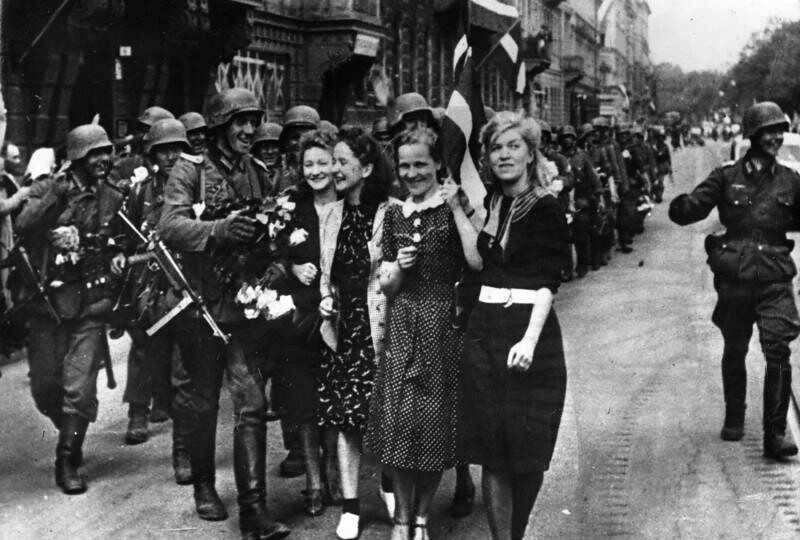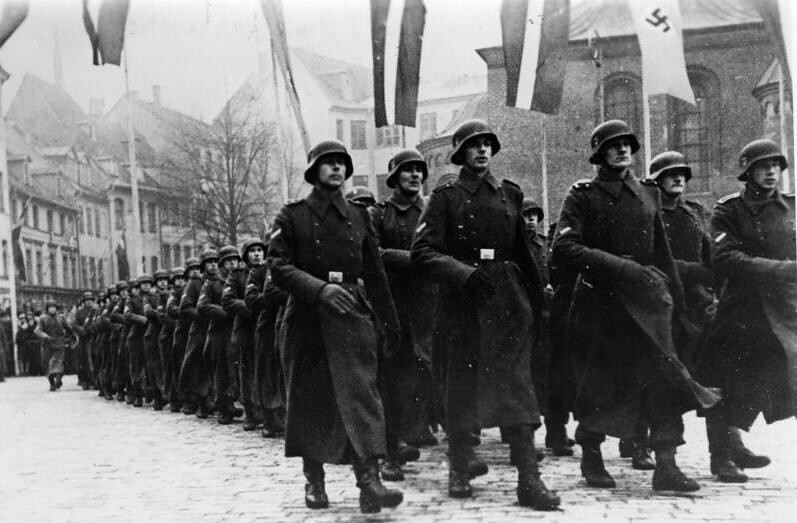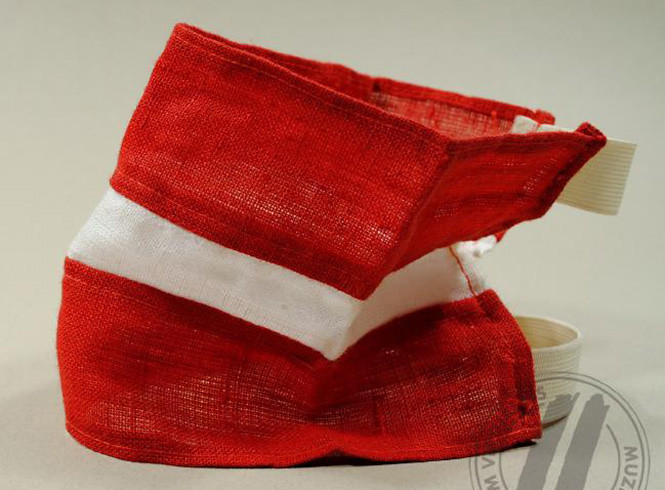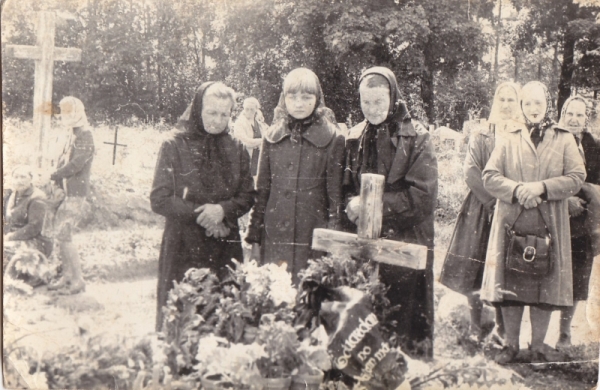Jānis Pīnups: a Latvian soldier for whom the Second World War finished in 1995
The stories of Japanese soldiers who were isolated after the end of World War II are famous. They not knowing -for some decades- that the war had come to an end.
The last of them, Teruo Nakamura, was arrested on the Maluku Islands (Indonesia) on 18 December 1974, returning to Taiwan -his homeland- almost three decades after the end of the war. It is a surprising story, but there is another that is still more: its protagonist was Jānis Pīnups.
Latvia in the inter-war period
But before you know his story, let's look at the context. The Baltic republics were included in the secret protocol of the Ribbentrop-Mólotov Pact, signed by Germany and the USSR in August 1939. This protocol established that the northern border of Lithuania -that is, the line separating it from Latvia- would be the limit of the respective spheres of influence of the two powers. Recall that after being part of the Russian Empire, Latvia had declared its independence on November 18, 1918, a week after the end of World War I. On 1 December of that year the Red Army invaded the small country, outbreaking what the Latvians know as their War of Independence, in which they received the support of their Polish and Estonian neighbors and the one of the British Navy. The war ended in August 1920 with Latvian victory and the recognition of its independence by Soviet Russia. Almost five years later, on 10 May 1925, Jānis Pīnups was born in Pelēči, a small town in eastern Latvia, in a relatively well-off family, which had a house with 23.5 hectares of land, including woods.
Stalin invades the Baltic republics and unleashes a brutal repression
At the outbreak of World War II, and turning its back on its former Polish allies, Latvia declared itself neutral. That would do them no good in the face of Stalin's pretensions. In the spring of 1940, after the disastrous campaign with which it had tried to conquer Finland and that had given rise to the brief Winter War, the USSR directed its propaganda against Latvia and began to try to destabilize the small republic using the Latvian communists. On June 15, 1940 Stalin left theaters and invaded Lithuania. The next day he did the same with Estonia and Latvia, all after demanding that the three republics establish pro-Soviet governments. A month later the USSR organized elections to which only one puppet party of Moscow could participate. In Latvia, the new parliament, dominated by that single party, voted to annex Latvia to the USSR on July 21, 1940. Between the invasion and subsequent deportations and executions, the communists killed almost 300,000 people in a country that did not arrive To 2 million inhabitants.

German soldiers received as liberators in Riga, Latvia, July 1941 (Photo: Bundesarchiv / Wikimedia)
The Germans, welcomed as liberators in Latvia
Unlike Poland, where resistance began to form even before the Germans and Soviets completed the invasion of the country, Latvian resistance was not formed, except in very isolated cases, until Hitler launched his offensive against the USSR. The Soviet repression had been so brutal that the Latvians saw the German soldiers as liberators. In Riga, the Wehrmacht was greeted with flowers, applauses and hugs. Young Latvians who had been forced to join the Red Army deserted and rebelled against the NKVD, Stalin's political police, which was carrying out mass deportations in the country. When the Germans arrived in some parts of Latvia, they found that the Soviets had fled and the Latvian rebels had taken over. On 10 July the German invasion of Latvia was completed.
From the communist dictatorship to the nazi dictatorship
However, the liberators were not such: Latvia went from one dictatorship (communist) to another (the nazi). The Germans began a campaign of mass extermination of Latvian Jews and Gypsies and threatened anyone who rebelled against the Third Reich by executing or sending them to a concentration camp. As with the USSR, thousands of Latvians (more than 200,000) were forced to join the German Army. In addition, more than 87,000 Latvian volunteers joined the Latviešu Leģions (Latvian Legion) of the Waffen SS, consisting of two divisions of grenadiers.

Soldiers of the Latvian Legion of the Waffen SS parading in Riga in 1943 (Photo: Bundesarchiv / Wikimedia)
The Latvian Resistance
Under German occupation, the Latvian resistance was divided into two large factions: the loyal to the democratic government and the Sarkanie Partizāni (Red Partisans) related to the USSR. Democratic resistance was articulated around Latvijas Centrālā Padome (Latvian Central Council), founded in August 1943 and formed by parties of various tendencies, but since November 1941 there were groups such as Latviešu Nacionālistu Savienība (Latvian Nationalist Union) and Patriotu Organizācija (Patriot Organization). The insurgents were mainly engaged in propaganda against the German occupiers and in the making of sabotages. The Germans were cruel and implacable in their reprisals: they destroyed 99 villages, deported 6,000 villagers and executed 3,600 only at the beginning of 1943. After the arrival of the Red Army to Latvia in August 1944 the Latvian resistance, this time against the Soviets, became even more intense. Many Latvian deserters from the German and Soviet armies moved on to resistance, being known as the Meža Brāļi (Forest Brothers), in the same way as the fighters of the other two Baltic republics who resisted the Soviet occupation from Of 1944. Many of them were in uniform, with German and Soviet armament, and they wore bracelets with the Latvian flag (garnet, with a thin white stripe).

Armband used by Latvian anti-Soviet resistance (Photo: Jaukajiem.id.lv)
On December 10, 1944, Latvijas Nacionālo Partizānu Apvienība (Latvian National Partisan Organization) was formed, which would continue its guerrilla activity until 1953. Catholic priest Antons Juhņevičs, AKA "Vientulis", led since January 1945 the Tēvzemes Sargu (Partizānu) Apvienības, Patriotic Guard Organization (Partisan), which fought to restore democracy and independence of the country and that would come to an end with the capture and execution of Juhņevičs in 1947 at the hands of the Communists. On the other hand, after the German surrender in May 1945, about 4,000 members of the Latvian Legion went into the country's forests to move on to the guerrilla struggle against the Soviet occupation. Latvian anti-Soviet resistance came to count on about 10,000 combatants, receiving the support of a network formed by 40,000 people.

Latvian Partisans of the Latvijas Nacionālo Partizānu Apvienība (Photo: Jaukajiem.id.lv)
A escape of 250 kilometers on foot
The war was hard for the Pīnups family. Jānis's parents died of typhus. He was a student and attended the Vocational School of Jaunaglona, but at age 19 he was forcibly enlisted in the Red Army on August 26, 1944. He was given a brief military training in Aiviekste, Latvia, and was sent to the front in September, ordering his companions and him to attack the German tanks with no more weapons than their rifles. It participated in three attacks, the last of them in the forest of Madliena. He was wounded on September 19, 1944, remaining unconscious. When he woke up he saw that no one was left on the battlefield, neither Germans nor Russians. He was not sure where he was or how long he had been unconscious. He lay down deep in a thicket, until he heard voices of the Germans who were checking the corpses on the battlefield. Jānis thought that they would see him and waited for his destiny, but they did not discover him. The next day he saw Russian soldiers with an armor vehicle, but they did not say anything to him. Then he got up and started walking, determined to defect and return to his home in Pelēči. His escape was not easy: he had to walk 250 kilometers on foot. In addition, the defectors were executed (he saw how they killed two of them), so he had to avoid all Soviet controls. Hiding in the margins of a road, in bushes and forests, he managed to reach the village of Koknese, where farmers helped him by giving civilian clothes. He arrived at his home Pelēči at dusk on October 7, 1944, knocking the windows of his house.
Hidden for decades in a barn and in the woods
Jānis did not feel capable of killing anyone. He was a fervent Christian and prayed daily. He hid in a room of his house, and had a hiding place in the barn, under the dung, where he could hide in case of need. In moments of danger, moreover, he could refuge in the swamp and forest behind the house. In these conditions came the end of the war. Latvia had lost a quarter of its population, around half a million people. Of these, 195,000 were Jews, almost 93% of the Hebrew population that had the country in 1939. Many towns were devastated, their industry destroyed and -to the fullest- had been under the rule of Stalin's USSR.
One night, in 1949, being hidden in the forest, Jānis awoke and saw before him a wolf. He was still young and managed to chase it away. When she was out in the open she protected herself from the cold with a sheepskin coat. He thought his daily prayers kept him safe. When his family built a new house in the 1950s, the old house was abandoned and Pīnups took refuge in it, without electricity. He was very cautious and only came out when no neighbor could see him. In the evenings he tried to help his two brothers -Staņislavs and Edvards- and his sister Veronika- collecting mushrooms and berries in the forest, in which he also built several shelters in which to be able to hide if necessary. Staņislavs and Veronika did not form their own families to care for their brother Jānis. The Pīnups brothers were tall, stocky and blond, and Veronika was a beautiful woman. Many neighbors thought she did not want to marry out of pride, because she could not find a man good enough for her. However, the truth is that she could not leave his brother alone. She feared that if she married and a stranger entered the house, Jānis was denounced.
Several times Jānis was about to be discovered by the communist authorities. Once the police arrived at the barn and fired a machine gun, thinking there might be someone hiding there. In 1965 his sister bought him a battery operated radio. Jānis was very interested in everything that happened in the country, and he listened as much to the news of Latvia and Russia (he learned Russian by listening to the radio). One day, around 1970, he arrived at the center of the parish where he lived and met a man at a bus stop. The man addressed him: "I know you, only the name has been forgotten." Pīnups believed that after all this time no one would recognize him, and that incident made him even more cautious. In the late 1980s he was forced to go to Preiļi to visit a doctor, using a false name -Staņislavs Kurmis-, because of illness. It should be noted that Pīnups did not have documentation of a citizen of the USSR. When his brothers died, he had no more family than his sister Veronika. Jānis could no longer help her cut wood, for her neighbors had once asked Veronika who was the man who visited her from time to time, and he feared being discovered. Only Veronika and a few trusted neighbors knew the existence of Jānis, but all kept the secret. When someone asked, they said that Jānis had died in the war.

Veronika Pīnups (right, after the cross) at the funeral of his brother Edvards (Poto: Latvija20Gadsimts.lv)
The last 'Forest Brother' 50 years after the end of the war
Jānis was convinced that the communists would disappear from Latvia. He did not believe in Soviet power and he was convinced that Latvia would be free again. So it was. With the fall of communism, Latvia declared its independence on May 4, 1990. The USSR deployed military, police and KGB forces in Latvia. In January 1991 thousands of Latvians took to the streets and formed barricades, registering clashes with the Soviet Police. After the Moscow coup d'état in August 1991, the Soviet Union recognized Latvian independence on 6 September 1991. But even so, Pīnups did not want to be exposed, as there were still Soviet troops in the country. Nevertheless, his last years of confinement were more relaxed, because sometimes he went to the church and approached other towns. In the end, he had become a stranger even to himself. The last Russian military left Latvia in August 1994, and Pīnups only dared to emerge nine months later, at the age of 70. He was the last "Forest Brother" of the Baltic republics.

Jānis Pīnups (in the center) shaking the hand of a Latvian policeman after legalizing his situation in 1995 (Photo: Latvija20Gadsimts.lv)
On May 9, 1995, 50 years and 2 days after the German surrender in World War II, Jānis Pīnups entered the Pelēči Police Station to inform the agents that he had been hiding for half a century. He was granted Lithuanian citizenship and went to live with his sister Veronika, because he had no family left. He was initially told that he was not right to a pension, but later his services to the Latvian nation were acknowledged. He never considered himself a hero, and always attributed to God the fact that he had survived hidden for so many years: "I go to church every Sunday," he declared in his last years of life. Veronika died in 2004, and Jānis was left alone in his home. He died on June 15, 2007, at the age of 82. The old house that served as a shelter and the hideout of the barn were demolished. Her sheepskin coat is preserved today in the Regional Historical Museum of Arendole. The house of his family nowadays belongs to the family of a grandson of Edvards, brother of Jānis. In 2015 the Australian playwright of Latvian origin Janis Balodis wrote a play entitled "Miškinis" (Man of the Forest), inspired by Jānis Pīnups and talking about a man hiding for 50 years, undocumented, in the Soviet Union.
Bibliograph
- Latvija20Gadsimts.lv / It contains information about Jānis and his brothers, in Latvian.
- Partizānu un dumpinieku kustības. Teorija, prakse, secinājumi / Information about Jānis in Latvian and Russian. The web is no longer available, but I've retrieved it by Google's cache
- Nekropole.info / Valiant testimony of Jānis Sokolovsky, grandson of Edwards, about his uncle-grandfather Jānis. In Latvian.
|
Don't miss the news and content that interest you. Receive the free daily newsletter in your email: |
- Most read
- The 'hole' without civil flights around Paris during the opening of the Olympic Games
- Stunning footage of the F-15QA Ababil in flight recorded from its cockpit
- The firearms used by the Pontifical Swiss Guard, the smallest army in the world
- The most distant deployment of the Spanish Air Force in Australia and New Zealand
- Eurofighter vs F-35: the opinions of professional pilots on these advanced fighters
- The first photo of an F-16 fighter with Ukrainian insignia and the details it has revealed
- This is the driver station of an M1 Abrams tank and the impressive start of its engine

 ES
ES







Comentarios:
agusbou2015
This soldier has an entry on Wikipedia:
https://en.m.wikipedia.org/wiki/J%C4%81nis_P%C4%ABnups
21:58 | 16/06/17
Elentir
I know, and it served me to know him, but there are data on Wikipedia that are incorrect. For example, it speaks of bunkers, but Jānis did not build any bunker. He had shelters. I had to check that and other data and I ended up looking for more reliable sources, all Latvian ones.
22:17 | 16/06/17
Opina sobre esta entrada: